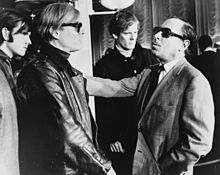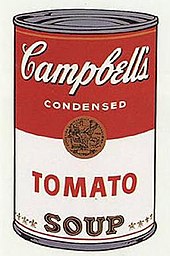Andy Warhol (August 6, 1928 – February 22, 1987) was an American artist who was a leading figure in the visual art movementknown as pop art. His works explore the relationship between artistic expression, celebrity culture and advertisement that flourished by the 1960s. After a successful career as a commercial illustrator, Warhol became a renowned and sometimes controversial artist. The Andy Warhol Museum in his native city, Pittsburgh, Pennsylvania, holds an extensive permanent collection of art and archives. It is the largest museum in the United States of America dedicated to a single artist.
Warhol's artwork ranged in many forms of media that include hand drawing, painting, printmaking, photography, silk screening, sculpture, film, and music. He was a pioneer in computer-generated art using Amiga computers that were introduced in 1985, just before his death in 1987. He founded Interview Magazine and was the author of numerous books, including The Philosophy of Andy Warhol and Popism: The Warhol Sixties. Andy Warhol is also notable as a gay man who lived openly as such before the gay liberation movement. His studio, The Factory, was a famous gathering place that brought together distinguished intellectuals, drag queens, playwrights, Bohemian street people, Hollywood celebrities, and wealthy patrons.
Warhol has been the subject of numerous retrospective exhibitions, books, and feature and documentary films. He coined the widely used expression "15 minutes of fame". Many of his creations are very collectible and highly valuable. The highest price ever paid for a Warhol painting is US$100 million for a 1963 canvas titled Eight Elvises. The private transaction was reported in a 2009 article in The Economist, which described Warhol as the "bellwether of the art market".[1] Warhol's works include some of themost expensive paintings ever sold.
Early life (1928–1949)
Andy Warhol (né Andrej Varchola, Jr.) was born on August 6, 1928 in Pittsburgh, Pennsylvania.[2] He was the fourth child of Ondrej Varchola (Americanized as Andrew Warhola, Sr., 1889-1942)[3] and Júlia (née Zavacká, 1892–1972),[4] whose first child was born in their homeland and died before their move to the U.S. Andy had two older brothers, Paul, born about 1923, and John, born about 1925.
His parents were working-class Rusyn[5][6][7] emigrants from Mikó (now called Miková), located in today’s northeastern Slovakia, part of the former Austro-Hungarian Empire. Warhol's father immigrated to the United States in 1914, and his mother joined him in 1921, after the death of Warhol's grandparents. Warhol's father worked in a coal mine. The family lived at 55 Beelen Street and later at 3252 Dawson Street in theOakland neighborhood of Pittsburgh.[8] The family was Byzantine Catholic and attended St. John Chrysostom Byzantine Catholic Church. Andy Warhol had two older brothers — Pavol (Paul), the oldest, was born in Slovakia; Ján was born in Pittsburgh. Pavol's son, James Warhola, became a successful children's book illustrator. About 1939, he started to collect autographed cards of film stars.
In third grade, Warhol had chorea, the nervous system disease that causes involuntary movements of the extremities, which is believed to be a complication of scarlet fever and causes skin pigmentation blotchiness.[9] He became a hypochondriac, developing a fear of hospitals and doctors. Often bedridden as a child, he became an outcast at school and bonded with his mother.[10] At times when he was confined to bed, he drew, listened to the radio and collected pictures of movie stars around his bed. Warhol later described this period as very important in the development of his personality, skill-set and preferences. When Warhol was 13, his father died in an accident.[11]
As a teenager, Warhol graduated from Schenley High School in the year 1945. Though not medically diagnosed, Andy may have had dyslexia, which might have contributed to the broadening of his imagination for art and as a result to have perceived the world differently. After graduating from high school, his intentions were to study art education at the University of Pittsburgh in the hope of becoming an art teacher, but his plans changed and he enrolled in theCarnegie Institute of Technology in pursuit of an art career as a commercial illustrator. In 1949, he earned a Bachelor of Fine Arts in Graphic Design.
Phases of his artwork by decade
1950s
Warhol showed early artistic talent and studied commercial art at the School of Fine Arts at Carnegie Institute of Technology in Pittsburgh, Pennsylvania, (now Carnegie Mellon University).[12] In 1949, he moved to New York City and began a career in magazine illustration and advertising. During the 1950s, he gained fame for his whimsical ink drawings of shoe advertisements. These were done in a loose, blotted-ink style, and figured in some of his earliest showings at the Bodley Gallery in New York. With the concurrent rapid expansion of the record industry and the introduction of the vinyl record, Hi-Fi, and stereophonic recordings, RCA Records hired Warhol, along with another freelance artist, Sid Maurer, to design album covers and promotional materials.[13]
Warhol was an early adopter of the silk screen printmaking process as a technique for making paintings. His earliest silkscreening in painting involved hand-drawn images though this soon progressed to the use of photographically derived silkscreening in paintings. Prior to entering the field of fine art, Warhol's commercial art background also involved innovative techniques for image making that were somewhat related to printmaking techniques. When rendering commercial objects for advertising Warhol devised a technique that resulted in a characteristic image. His imagery used in advertising was often executed by means of applying ink to paper and then blotting the ink while still wet. This was akin to aprintmaking process on the most rudimentary scale.[14] Warhol's work both as a commercial artist and later a fine artist displays a casual approach to image making, in which chance plays a role and mistakes and unintentional marks are tolerated. The resulting imagery in both Warhol's commercial art and later in his fine art endeavors is often replete with imperfection — smudges and smears can often be found. In his book "POPism" Warhol says, "... when you do something exactly wrong, you always turn up something."[15][16][17]
1960s
He began exhibiting his work during the 1950s. He held exhibitions at the Hugo Gallery,[18] and the Bodley Gallery[19] in New York City and in California his first one-man art-gallery exhibition[20][21] was on July 9, 1962, in the Ferus Gallery of Los Angeles. The exhibition marked his West Coast debut of pop art.[22] Andy Warhol's first New York solo pop art exhibition was hosted at Eleanor Ward's Stable Gallery November 6–24, 1962. The exhibit included the works Marilyn Diptych, 100 Soup Cans, 100 Coke Bottles and 100 Dollar Bills. At the Stable Gallery exhibit, the artist met for the first time poet John Giorno who would star in Warhol's first film, Sleep, in 1963.[23]
It was during the 1960s that Warhol began to make paintings of iconic American objects such as dollar bills, mushroom clouds, electric chairs, Campbell's Soup Cans, Coca-Cola bottles, celebrities such as Marilyn Monroe, Elvis Presley, Troy Donahue, Muhammad Ali andElizabeth Taylor, as well as newspaper headlines or photographs of police dogs attacking civil rights protesters. During these years, he founded his studio, "The Factory" and gathered about him a wide range of artists, writers, musicians, and underground celebrities. His work became popular and controversial. Warhol had this to say about Coca Cola:
What's great about this country is that America started the tradition where the richest consumers buy essentially the same things as the poorest. You can be watching TV and see Coca-Cola, and you know that the President drinks Coca-Cola, Liz Taylor drinks Coca-Cola, and just think, you can drink Coca-Cola, too. A Coke is a Coke and no amount of money can get you a better coke than the one the bum on the corner is drinking. All the cokes are the same and all the cokes are good. Liz Taylor knows it, the President knows it, the bum knows it, and you know it.[24]
New York's Museum of Modern Art hosted a Symposium on pop art in December 1962 during which artists like Warhol were attacked for "capitulating" to consumerism. Critics were scandalized by Warhol's open embrace of market culture. This symposium set the tone for Warhol's reception. Throughout the decade it became increasingly clear that there had been a profound change in the culture of the art world, and that Warhol was at the center of that shift.[citation needed]
A pivotal event was the 1964 exhibit The American Supermarket, a show held in Paul Bianchini's Upper East Side gallery. The show was presented as a typical U.S. small supermarket environment, except that everything in it — from the produce, canned goods, meat, posters on the wall, etc. — was created by six prominent pop artists of the time, among them the controversial (and like-minded) Billy Apple, Mary Inman, and Robert Watts. Warhol's painting of a can of Campbell's soup cost $1,500 while each autographed can sold for $6. The exhibit was one of the first mass events that directly confronted the general public with both pop art and the perennial question of what art is (or of what is art and what art not art).[citation needed]
As an advertisement illustrator in the 1950s, Warhol used assistants to increase his productivity. Collaboration would remain a defining (and controversial) aspect of his working methods throughout his career; this was particularly true in the 1960s. One of the most important collaborators during this period was Gerard Malanga. Malanga assisted the artist with the production of silkscreens, films, sculpture, and other works at "The Factory," Warhol's aluminum foil-and-silver-paint-lined studio on 47th Street (later moved to Broadway). Other members of Warhol's Factory crowd included Freddie Herko, Ondine, Ronald Tavel, Mary Woronov, Billy Name, and Brigid Berlin (from whom he apparently got the idea to tape-record his phone conversations).[25]
During the 1960s, Warhol also groomed a retinue of bohemian eccentrics upon whom he bestowed the designation "Superstars", including Nico,Joe Dallesandro, Edie Sedgwick, Viva, Ultra Violet, Holly Woodlawn, Jackie Curtis and Candy Darling. These people all participated in the Factory films, and some — like Berlin — remained friends with Warhol until his death. Important figures in the New York underground art/cinema world, such as writer John Giorno and film-maker Jack Smith, also appear in Warhol films of the 1960s, revealing Warhol's connections to a diverse range of artistic scenes during this time.





